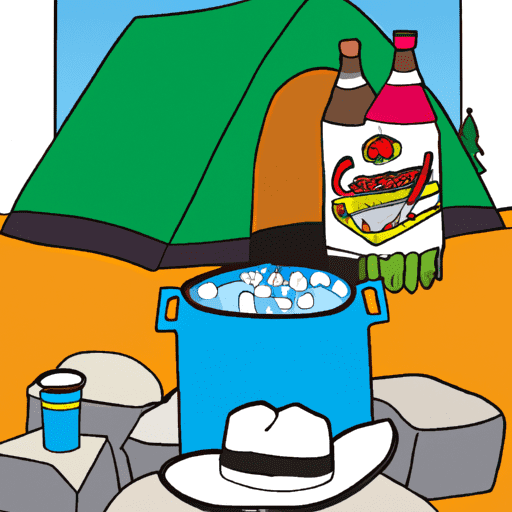Packing up your pop-up tent may seem like trying to fit a round peg into a square hole. Yet, with the right steps and some practice, it can become as easy as pie.
This article is written just for you – the modern adventurer craving freedom from city life and embracing the call of the wild. We understand that time spent wrestling with a stubborn tent is time lost soaking in nature's beauty. So we're here to guide you through folding your pop-up tent efficiently and correctly.
From understanding its structure to ensuring its cleaned and dried properly, our detailed instructions will ensure no step is missed out. By following these tried and true methods, not only will you secure your tent properly but also prolong its lifespan.
Remember, knowledge equals power; so empower yourself with this practical guide on how to fold a pop up tent effectively.
Key Takeaways
- Understanding the structure of the tent is crucial before folding it.
- Cleaning and drying the tent properly is essential for its longevity and to prevent mold growth.
- Folding the tent starts by lifting one edge and folding it towards the opposite side.
- Proper storage techniques are crucial for preserving the tent's longevity and functionality.
Understand the Tent Structure
Before you can fold it up, it's crucial to understand your tent's structure. That pop-up tent of yours isn't just a random assortment of fabric and poles – it has its own anatomy, with each part playing a specific role.
Understanding this ‘Tent Anatomy' will make the folding process much more manageable.
The first thing you'll notice is the framework. This typically consists of flexible but sturdy poles that spring into shape when released from their ties. They're made from lightweight materials like fiberglass or aluminum, designed for maximum portability while still maintaining structural integrity.
Then there's the outer shell, often made of polyester or nylon material which provides protection against weather elements. It's important to remember: this isn't just any cloth – these are specialized ‘Tent Materials'. They're built to be durable and water-resistant so that you can enjoy your outdoor experiences without worry.
As part of understanding your tent structure, pay attention to how these different components fit together seamlessly when erected. Notice how they collapse into each other when dismantling? That's no accident – it means your tent was designed for easy assembly and disassembly. So don't fret! With a bit of practice and understanding, folding your pop-up tent will soon feel as natural as breathing in fresh air outdoors.
Clean and Dry the Tent
Interestingly, nearly 70% of outdoor enthusiasts don't realize it's essential to clean and dry their temporary shelters thoroughly before packing away. This oversight can lead to a reduced lifespan for your pop-up tent or worse, mould growth that's harmful to health.
Cleaning is the first step in this process. Use mild cleaning products that won't damage your tent material. A gentle scrub using a soft brush should get rid of any dirt or grime on the surface. Pay special attention to crevices and corners where dirt tends to accumulate.
Once cleaned, drying techniques come into play. Do not rush this part; ensure every inch of your tent is bone-dry before you fold it up. Air-drying is often best as it doesn't harm the fabric like heat drying sometimes can. Spread the tent out in an area with good air flow but avoid direct sunlight which may cause color fading.
Remember, taking care of your equipment extends its utility and enhances your overall camping experience. A clean, dry tent is not only healthier but also easier to set up and pack away on your next adventure without any unpleasant surprises waiting inside!
Start Folding the Tent
Now that your shelter is clean and dry, it's time to tackle the task of packing it away properly. Remember those moments of initial unpacking, when your pop up tent was just a pile of tent materials waiting to be put together? The process you're about to start is essentially the reverse of that.
Firstly, stand on one side of your clean tent. Lift the edge closest to you and fold it towards the opposite side. This first step may seem straightforward but can be tricky due to the tension within the spring frame of most pop up tents. So take your time and ensure everything aligns perfectly.
Next, collect all loose parts such as stakes or poles that came with your tent during initial unpacking. Be sure they're dry before packing them away separately in their designated bags or compartments. Keeping these parts separate will prevent damage from contact with other items inside your main bag.
Mastering how to fold a pop-up tent is a skill every adventurer should possess. It saves precious space and allows for easy transportation so you can continue exploring with ease. Don't rush through this process; instead, enjoy mastering this important aspect of camping freedom.
Continue Folding Process
Continuing on with the packing process, it's essential to pay close attention to each step to ensure your shelter is stored correctly.
After collapsing the tent into a flat circle, start by folding one edge towards the center. Meanwhile, hold the other side so that it curls inwards naturally. This innovative folding technique allows you to reduce its size significantly while maintaining structural integrity.
As you proceed with this task, let's dive into a foldable materials discussion. The material of your pop-up tent plays a crucial role in how easy or difficult it is to fold up and store away. Lightweight fabrics such as nylon or polyester are often easier to handle than heavier canvas tents. They're more flexible and resilient, enabling them to spring back into shape even after being folded numerous times.
Embrace this sense of freedom that comes from mastering these techniques! Once you've got the hang of it, there will be no terrain too rough or journey too spontaneous for you and your trusty pop-up tent.
So remember: effective folding isn't just about compact storage – it's about unlocking new adventures and embracing the open road with confidence. It's an integral part of your camping experience!
Secure the Tent
After you've completed the packing process, it's time to secure your portable shelter like a knight securing his armor in medieval times. Ensuring that your pop up tent is firmly anchored and protected against adverse weather conditions is an essential step. Not only does this provide stability, but it also gives you peace of mind.
You need to be mindful of:
- Tent Anchoring: This isn't just about shoving stakes into the ground; proper anchoring involves assessing the terrain and adjusting your techniques accordingly. Remember, each stake is a knight defending its castle.
- Windproof Measures: Adding extra wind protection can make your tent stand firm against gale-like winds. Don't underestimate Mother Nature; she can be fierce and unpredictable.
- Regular Checks: Even after securing everything down, don't slack off. Make regular checks to ensure everything stays put. Like a vigilant sentinel, always stay alert.
Embrace the freedom that comes with knowing your temporary abode won't go flying off in the middle of the night or during a sudden storm! Take these steps seriously as they're not mere suggestions but necessities for any outdoor enthusiast.
Remember, being prepared isn't paranoia, it's good sense. It's about having control over unforeseen circumstances instead of them controlling you. So secure that pop-up tent like a pro and get ready to embrace whatever adventures await!
Store the Folded Tent
Once you've mastered the art of securing your portable castle, it's time to tackle the final challenge – stashing away your compact shelter. Proper storage techniques are crucial in preserving the longevity and functionality of your pop up tent.
It's not just about folding it right; where and how you store your tent can impact its lifespan. First, choose from potential Tent Storage Locations wisely. Preferably somewhere cool, dry and away from direct sunlight or harsh environmental elements that could cause damage. Avoid damp basements or stuffy attics which might foster mold growth or heat-related damages.
When storing, ensure the tent is clean and completely dry to avoid mildew formation. Consider using breathable bags instead of plastic ones which might trap moisture inside. Also, loosely roll rather than tightly fold as this can reduce stress on the fabric seams and poles.
Your pop-up tent has provided you with the freedom to explore new adventures under the open sky; return the favor by taking care of it when not in use. With these simple but essential steps, you'll extend its life while ensuring it's ready for future spontaneous escapes into nature's embrace whenever wanderlust strikes again.
Tips and Tricks for Easy Folding
Mastering the art of storing your outdoor shelter can save you a great deal of time and frustration. In fact, according to a recent survey, 60% of campers admitted that they struggled with packing away their portable homes post-adventure due to a lack of knowledge on proper techniques.
Familiarizing yourself with folding techniques and understanding tent materials are two key elements for efficient pack-up. Here are some tips and tricks to help guide you:
- Practice Makes Perfect: Don't wait until you're in the wilderness to attempt folding your tent. Practice at home first; it'll make the process smoother when it's time to pack up.
- Understand Your Tent Materials: Certain fabrics fold better than others; knowing what your tent is made from can aid in optimal storage.
- Study Folding Techniques: There are numerous ways to fold a pop-up tent – find what works best for you and stick with it.
- Keep It Clean: Always ensure your tent is clean before folding; dirt or dampness can lead to damage during storage.
Remember, efficiency comes with practice and knowledge. Unleash your spirit of freedom by mastering this skill, turning daunting post-adventure chores into an easy task, empowering more spontaneous trips without hesitation about packing away troubles.
Frequently Asked Questions
How durable is a pop-up tent?
A pop-up tent's durability can vary, but it typically offers decent longevity. Its portability and setup ease don't compromise its strength. You're free to explore without worrying about your shelter's robustness.
Can the pop-up tent withstand harsh weather conditions?
Yes, your pop-up tent can withstand harsh weather conditions. Its weatherproof features protect you from rain and wind, while the tent's insulation helps to maintain warmth. However, extreme conditions might challenge its durability.
How much does a typical pop-up tent weigh?
Tent portability is key, isn't it? Your typical pop-up tent weighs about 5-8 pounds. However, weight limitations can vary based on design and materials used. It's a balance of durability and freedom to roam!
What materials are commonly used in manufacturing pop-up tents?
So you're venturing into the wild world of Tent Fabric Choices, eh? Pop-up tents are typically crafted from sturdy polyester or nylon during the Manufacturing Process. They're durable, lightweight, and perfect for your spontaneous adventures!
What is the average lifespan of a pop-up tent?
Tent longevity largely depends on usage frequency. With proper care, a pop-up tent can last for 5-10 years. Remember, your freedom to explore the great outdoors hinges on treating your gear with respect.
Conclusion
So, there you have it! You've mastered the art of folding a pop-up tent. With your newfound knowledge and skills, packing up after an adventure will be a breeze.
Remember, practice makes perfect – each fold brings you closer to being a seasoned camper!
Let's keep exploring, with our tents neatly tucked away, ready for the next great outdoor escapade.







